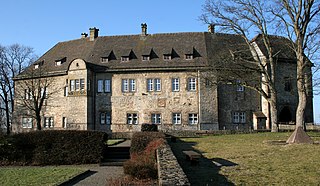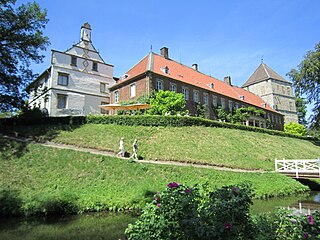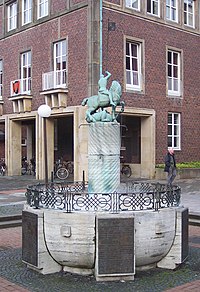
Münster is an independent city in North Rhine-Westphalia, Germany. It is in the northern part of the state and is considered to be the cultural centre of the Westphalia region. It is also a state district capital. Münster was the location of the Anabaptist rebellion during the Protestant Reformation and the site of the signing of the Treaty of Westphalia ending the Thirty Years' War in 1648. Today, it is known as the bicycle capital of Germany.
Borken is a Kreis (district) in the northwestern part of North Rhine-Westphalia, Germany in the Münster region. Neighboring districts are Steinfurt, Coesfeld, Recklinghausen, Wesel, Cleves, Bentheim in the Lower Saxony and the Dutch provinces Gelderland and Overijssel. The two biggest cities are Bocholt and Gronau.

Wesel is a city in North Rhine-Westphalia, Germany. It is the capital of the Wesel district.

Barntrup is a town in the Lippe district of North Rhine-Westphalia, Germany. It has an area of 59.46 km2 and 8,501 inhabitants (2019). It lies 40 km east from Bielefeld and 9 km west from Bad Pyrmont at the east border of NRW to Lower Saxony.

Coesfeld is the capital of the district of Coesfeld in the German state of North Rhine-Westphalia.

Dülmen is a town in the district of Coesfeld, North Rhine-Westphalia, Germany.

Zülpich is a town in North Rhine-Westphalia, Germany between Aachen and Bonn. It belongs to the district of Euskirchen.

Werne an der Lippe is a town in the Federal state of North Rhine-Westphalia in the Unna district in Germany. It is located on the southern edge of the Münsterland region near the Ruhrgebiet. The population of Werne is about 32,000.

Kaarst is a town in Germany. It lies in the district of Rhein-Kreis Neuss in North Rhine-Westphalia. It is 5 km west of Neuss and 12 km east of Mönchengladbach.

Olfen is a town in the district of Coesfeld, in North Rhine-Westphalia, Germany.

Vreden is a small town in North Rhine-Westphalia, Germany near the Dutch border. The town is located near the river Berkel. The first mentioning of the town is proven for the year 839. In 1252 Vreden obtained city rights.

Bad Driburg is a town and spa in Höxter district in North Rhine-Westphalia, Germany, situated on the river Aa and the Altenbeken–Kreiensen railway.

Kranenburg is a municipality in the district of Cleves in the state of North Rhine-Westphalia, Germany. It is located near the border with the Netherlands, 12 kilometres (7 mi) south-east of Nijmegen and 11 kilometres (7 mi) west of Cleves.

Rheda-Wiedenbrück is a city in the district of Gütersloh, in North Rhine-Westphalia, Germany.

Ibbenbüren is a town in the district of Steinfurt, in North Rhine-Westphalia, Germany.

Neukirchen-Vluyn is a town in the district of Wesel, in North Rhine-Westphalia, Germany. It is situated approximately 5 km west of Moers, and 15 km north of Krefeld.

Schloss Nordkirchen is a palace situated in the town of Nordkirchen in the Coesfeld administrative district in the state of North Rhine Westphalia, Germany. The schloss was largely built between 1703 and 1734 and is known as the "Versailles of Westphalia" since it is the largest of the fully or partly moated Wasserschlösser in that region. It was originally one of the residences of the Prince-Bishopric of Münster.

The House of Merveldt is the name of an ancient Westphalian aristocratic family, which belongs to the German nobility of the Middle Ages. The Herrn (Lords) von Merveldt were among the oldest families in the Münsterland. Merfeld, the eponymous seat of the family, is now a neighborhood of the city of Dülmen in the District of Coesfeld in the state of North Rhine-Westphalia in Germany.
The County of Diepholz, that was first known as the Lordship of Diepholz, was a territory in the Holy Roman Empire in the Lower-Rhenish-Westphalian Circle. It was ruled by the Noble Lords, later Counts, of Diepholz from the late tenth century until 1585, when it was mostly incorporated into the Duchy of Brunswick-Lüneburg.

The County of Steinfurt, originally the Lordship of Steinfurt, was a historic territory of the Holy Roman Empire in the Munsterland. It existed from roughly 1100 until 1806.























